Blog & Latest Updates
Fly Fishing Articles
Insects by Common Name


Mayfly Family Baetidae (Blue-Winged Olives)
Taxonomic Navigation -?-
Kingdom
Animalia (Animals)
» Phylum
Arthropoda (Arthropods)
» Class
Insecta (Insects)
» Order
Ephemeroptera (Mayflies)
» Family Baetidae (Blue-Winged Olives)
11 genera aren't included.
Common Name
| Match | Common Name |
| Blue-Winged Olives |
This is page 4 of specimens of Baetidae. Visit the main Baetidae page for:
- The behavior and habitat of Baetidae.
- 10 underwater pictures of Baetidae.
Pictures of 103 Mayfly Specimens in the Family Baetidae:
Female Baetidae (Blue-Winged Olives) Mayfly Dun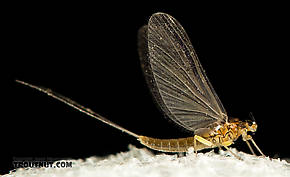 View 5 Pictures
View 5 Pictures
 View 5 Pictures
View 5 PicturesCollected July 11, 2017 from the North Fork Stillaguamish River in Washington
Added to Troutnut.com by Troutnut on July 12, 2017
Added to Troutnut.com by Troutnut on July 12, 2017
Female Baetidae (Blue-Winged Olives) Mayfly Dun View 5 PicturesI captured this dun on the same night as a spinner which is probably of the same species.
View 5 PicturesI captured this dun on the same night as a spinner which is probably of the same species.
 View 5 PicturesI captured this dun on the same night as a spinner which is probably of the same species.
View 5 PicturesI captured this dun on the same night as a spinner which is probably of the same species.Collected August 9, 2006 from the West Branch of Owego Creek in New York
Added to Troutnut.com by Troutnut on August 11, 2006
Added to Troutnut.com by Troutnut on August 11, 2006
Female Anafroptilum album (Tiny Sulphur Dun) Mayfly Dun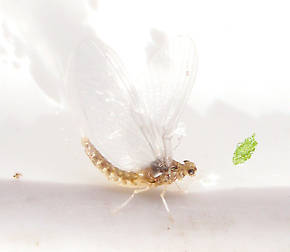 View 3 PicturesApprox. 5 mm. This is a very significant hatch. It is mostly seen at the height of Summer and I was very surprised to see it emerging this late in the season and in such numbers. When this one is emerging, the fish can become quite selective.
View 3 PicturesApprox. 5 mm. This is a very significant hatch. It is mostly seen at the height of Summer and I was very surprised to see it emerging this late in the season and in such numbers. When this one is emerging, the fish can become quite selective.
 View 3 PicturesApprox. 5 mm. This is a very significant hatch. It is mostly seen at the height of Summer and I was very surprised to see it emerging this late in the season and in such numbers. When this one is emerging, the fish can become quite selective.
View 3 PicturesApprox. 5 mm. This is a very significant hatch. It is mostly seen at the height of Summer and I was very surprised to see it emerging this late in the season and in such numbers. When this one is emerging, the fish can become quite selective.Collected November 9, 2011 from the Fall River in California
Added to Troutnut.com by Entoman on December 10, 2011
Added to Troutnut.com by Entoman on December 10, 2011
Acerpenna pygmaea (Tiny Blue-Winged Olive) Mayfly Nymph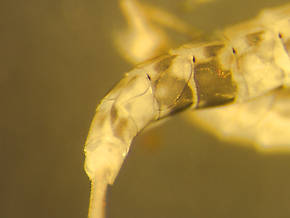 View 3 PicturesThis is a very rare mayfly in western Montana. The shape of the last gill is a key to its identification. I have collected this species in only one location.
View 3 PicturesThis is a very rare mayfly in western Montana. The shape of the last gill is a key to its identification. I have collected this species in only one location.
 View 3 PicturesThis is a very rare mayfly in western Montana. The shape of the last gill is a key to its identification. I have collected this species in only one location.
View 3 PicturesThis is a very rare mayfly in western Montana. The shape of the last gill is a key to its identification. I have collected this species in only one location.Collected May 5, 2007 from the Upper Stillwater River in Montana
Added to Troutnut.com by Bnewell on June 26, 2011
Added to Troutnut.com by Bnewell on June 26, 2011
Baetidae (Blue-Winged Olives) Mayfly Nymph View 2 PicturesHere's a rather different tiny Baetid nymph. The tails are all unbanded, and the tergites (
View 2 PicturesHere's a rather different tiny Baetid nymph. The tails are all unbanded, and the tergites (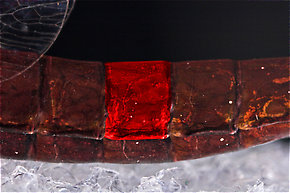 Tergite: The top (dorsal) part of a single segment on an insect's abdomen when it consists of a single chitinous plate (sclerite), or an individual sclerite if the segment has more than one.) all have a dark-colored anterior (Anterior: Toward the front of an organism's body. The phrase "anterior to" means "in front of.") 2/3 and light-colored posterior (Posterior: Toward the back of an organism's body. The phrase "posterior to" means "in back of.") 1/3. The gill veinlets (Veinlet: Short insect wing veins connecting the major longitudinal veins to the wing margin.) are indistinct. It's probably a very early instar (Instar: Many invertebrates molt through dozens of progressively larger and better-developed stages as they grow. Each of these stages is known as an instar. Hard-bodied nymphs typically molt through more instars than soft-bodied larvae.) of some Baetis species.
Tergite: The top (dorsal) part of a single segment on an insect's abdomen when it consists of a single chitinous plate (sclerite), or an individual sclerite if the segment has more than one.) all have a dark-colored anterior (Anterior: Toward the front of an organism's body. The phrase "anterior to" means "in front of.") 2/3 and light-colored posterior (Posterior: Toward the back of an organism's body. The phrase "posterior to" means "in back of.") 1/3. The gill veinlets (Veinlet: Short insect wing veins connecting the major longitudinal veins to the wing margin.) are indistinct. It's probably a very early instar (Instar: Many invertebrates molt through dozens of progressively larger and better-developed stages as they grow. Each of these stages is known as an instar. Hard-bodied nymphs typically molt through more instars than soft-bodied larvae.) of some Baetis species.
 View 2 PicturesHere's a rather different tiny Baetid nymph. The tails are all unbanded, and the tergites (
View 2 PicturesHere's a rather different tiny Baetid nymph. The tails are all unbanded, and the tergites (
One tergite of this Isonychia bicolor mayfly spinner is highlighted in red.
Collected January 31, 2004 from unknown in Wisconsin
Added to Troutnut.com by Troutnut on January 25, 2006
Added to Troutnut.com by Troutnut on January 25, 2006
Baetidae (Blue-Winged Olives) Mayfly Nymph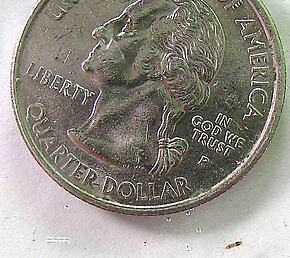 View 2 Pictures
View 2 Pictures
 View 2 Pictures
View 2 PicturesCollected January 13, 2004 from the Namekagon River in Wisconsin
Added to Troutnut.com by Troutnut on January 25, 2006
Added to Troutnut.com by Troutnut on January 25, 2006
Female Baetidae (Blue-Winged Olives) Mayfly Spinner View 3 Pictures
View 3 Pictures
 View 3 Pictures
View 3 PicturesCollected May 24, 2004 from unknown in Wisconsin
Added to Troutnut.com by Troutnut on January 25, 2006
Added to Troutnut.com by Troutnut on January 25, 2006
Baetidae (Blue-Winged Olives) Mayfly Nymph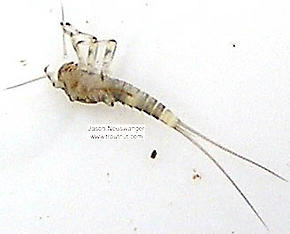 View 3 Pictures
View 3 Pictures
 View 3 Pictures
View 3 PicturesCollected February 5, 2004 from unknown in Wisconsin
Added to Troutnut.com by Troutnut on January 25, 2006
Added to Troutnut.com by Troutnut on January 25, 2006
Baetidae (Blue-Winged Olives) Mayfly Nymph View 3 PicturesThis little Baetid looks a little stiff because it died shortly before being photographed.
View 3 PicturesThis little Baetid looks a little stiff because it died shortly before being photographed.
 View 3 PicturesThis little Baetid looks a little stiff because it died shortly before being photographed.
View 3 PicturesThis little Baetid looks a little stiff because it died shortly before being photographed.Collected February 5, 2004 from the Bois Brule River in Wisconsin
Added to Troutnut.com by Troutnut on January 25, 2006
Added to Troutnut.com by Troutnut on January 25, 2006
Baetidae (Blue-Winged Olives) Mayfly Nymph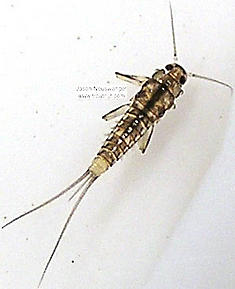 View 2 PicturesThis nymph has gills with indistinct veinlets (Veinlet: Short insect wing veins connecting the major longitudinal veins to the wing margin.), segments 5, 9, and 10 pale, a rounded 7th gill, and a very short middle tail.
View 2 PicturesThis nymph has gills with indistinct veinlets (Veinlet: Short insect wing veins connecting the major longitudinal veins to the wing margin.), segments 5, 9, and 10 pale, a rounded 7th gill, and a very short middle tail.
 View 2 PicturesThis nymph has gills with indistinct veinlets (Veinlet: Short insect wing veins connecting the major longitudinal veins to the wing margin.), segments 5, 9, and 10 pale, a rounded 7th gill, and a very short middle tail.
View 2 PicturesThis nymph has gills with indistinct veinlets (Veinlet: Short insect wing veins connecting the major longitudinal veins to the wing margin.), segments 5, 9, and 10 pale, a rounded 7th gill, and a very short middle tail.Collected February 7, 2004 from unknown in Wisconsin
Added to Troutnut.com by Troutnut on January 25, 2006
Added to Troutnut.com by Troutnut on January 25, 2006
Top 10 Fly Hatches
Top Gift Shop Designs
Eat mayflies.
Top Insect Specimens
Miscellaneous Sites
Troutnut.com is copyright © 2004-2024 Jason
Neuswanger (email Jason). See my FAQ for information about use of my images.
 privacy policy
privacy policy
